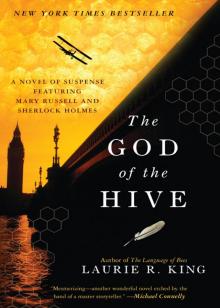- Home
- Laurie R. King
Lockdown Page 3
Lockdown Read online
Page 3
A school that sidled up and murmured sweet nothings in Linda’s astonished ear.
She’d held herself aloof during the Señora’s tour of Guadalupe, nodding and asking few questions, until the Señora stepped away and left her alone in the arched entranceway.
Its tiled walls had once been a mosaic. Under the years of filth, felt pens, and chewing gum lay a mural somebody had spent a lot of time on. Up at the top (beyond the reach of student arms) was a row of surprisingly ornate hand-painted tiles—a sort of picture frame, wrapped around a sky as blue as the afternoon beyond the archway.
Linda studied the brutalized surface, trying to pick out the design. The tiles themselves were a mix of tidy rectangles and anarchic shards: a long rectangle evoked the school’s façade; in the blue sky, a spatter of chips made for an Impressionistic, breeze-stirred flag; ten thin triangles shaped the circle of a wheelchair. Some of the tiles were painted, rather than pieced: a woman’s face here, obscured by felt pen beard and horns; a cluster of high-top shoes there; a brown hand sinking a basketball.
Linda stepped closer, her attention caught by that face: a woman with an expression of authority, captured in a few deft lines. Wasn’t that the school secretary?
Bemused, Linda let the Señora drive her back to the elementary school, all the while composing a refusal, polite but firm.
The job would be thankless. If Guadalupe’s new principal managed to get test scores up five points, the school board would demand to know why it wasn’t ten. If absenteeism and violence fell a notch, why not two? Playground bloodshed, drugs, and student pregnancy would be daily concerns. It would be terrifying and exhilarating and the mere thought of it made Linda want to take to her bed.
But that night, she had a dream of using her thumb-nail to scrape the felt pen from that tile face. The next morning, Gordon asked why her sleep had been so restless. As the day wore on, her thoughts kept going back to that mosaic. And when the final bell had rung, Linda picked up the phone and called the district office with a list of demands—a very long list.
Over the summer break, Guadalupe was turned inside-out: classrooms to teachers; sports equipment to art lab; math curriculum to wall maps; with new policies on cellphones, parent communication, sex ed, and bullying.
The school year started the third Wednesday in August. By the Friday night, Linda was exhausted, overwhelmed, and—yes—exhilarated. By Tuesday, she loved Guadalupe Middle School as ferociously as an elderly cat-lady with 712 runt kittens. She spent the next two months tracking their growth, worrying and obsessing and celebrating their every tiny victory—only to have the winds of winter sweep across her charges when pigtailed sixth-grader Bee Cuomo failed to reach school one morning.
Linda had lost children before, as a teacher and as a principal: leukemia, a gun accident, and one horrible weekend, three children from one family to a drunk driver. She well knew the shudders and cracks that ran through a school community, the fear and sense of abandonment and vulnerability that took time and attention to heal.
But she’d never before had a child simply…disappear. How the hell did one comfort and reassure children when no one knew what the threat even was? November dragged on, days and then weeks in limbo: no body, no ransom demand, no hint of sexual predator in the girl’s online life or family history. Nothing but a blankness that had swallowed a child.
The uncertainty was toxic and all pervasive, touching even those who’d never so much as met Bee Cuomo. Kids began acting up; parents fell off the wagon; playtime recklessness edged into self-destruction. As Linda watched her school cringe away from the media scrutiny on the one hand and the grinding fear of the unknown on the other, she knew it was tearing itself to shreds.
But for some reason, it stopped short. Somehow, her school full of damaged, recalcitrant, and neglected children had done the exact opposite of what the entire district expected: they hadn’t melted down. Instead, the kids seemed to feel the gaping absence of Bee Cuomo as a chasm yawning at their own feet, and slowly, by tiny, hard-fought increments, seemed to be clawing their way back from the edge.
The moment she’d realized this, Linda had furiously pushed everyone else away: outside experts, district overseers, trauma counselors, all the police other than Olivia Mendez. In recent weeks, she’d found herself holding her breath, trying not to look at things too closely, and doing nothing that might disturb this fragile equilibrium. She’d put off making a decision about what kind of memorial service to hold. She’d let the district know that the testing schedule could go on as planned. She’d refused to cancel events like Career Day.
Any one of those decisions might prove disastrous, but…
“Today will go fine,” she said aloud into the dark bedroom. Once upon a time, it would have been a prayer. Today, all Linda felt entitled to ask of the universe was that Gordon had left some coffee in the pot.
5:50 A.M.
Chaco
Chaco woke up to the smell of coffee and the sound of his mother’s shoes, scuffling across the old floor. Weariness, his mind offered. Retribution.
He’d got, what? Two hours of sleep? He’d been awake till he went out the kitchen door at 2:15, and got back maybe an hour later. Then just when his feet were starting to warm up, a little voice sneered, Hey stupid, you think that light mighta been hooked up to a camera? His heart pounded so loud he thought it would wake up his little brother—until he forced himself to think, like cousin Taco. The light was at your back, right? And you didn’t turn to look, did you? So what if a camera took his picture? All it would show was some kid wearing too-big overalls and dirty shoes. Just a kid.
Still, it took Chaco a while to feel warm again, and what seemed like five minutes later Mamá came in with the cup of mostly-milk coffee and the gentle shake on his shoulder. The coffee was her way of saying he was doing a man’s work. The shake told him it had to be now.
He threw back the covers and put his bare feet on the floor—harder to fall asleep if you were sitting up. Vigilant, that was him. When his mother looked in a few minutes later he wasn’t exactly awake, but the mug was still in his hands. She crossed the room to give him a kiss, and to whisper that there were some eggs if he wanted to cook those, but not to put cheese in his sister’s until they found out what was causing her stomach problems. When he didn’t answer, she asked if he was all right.
He grumbled he was fine and stood up to prove it. They both heard the car door slam, two doors down, which meant her ride would be outside in a minute. He made a little wave toward the hallway, then followed her along the icy linoleum to the kitchen, the only room they kept warm in the winter.
She looked up from buttoning her coat. “I nearly forgot. They called last night and asked if I could work Saturday. I said yes.”
“Oh, Ma.”
“I know, I told you I wouldn’t, but it’s time and a half, and I thought I could ask Angel to—”
“No!”
“He can borrow a car seat for your sister, and—”
“No, Mamá, promise me you won’t ask him. Angel is…” Angel is what? Crazy? Dangerous? Malignant? “Angel’s got things to do. The little ones like the swings in the park. We can walk down there.”
“He said he didn’t mind. That maybe he’d meet some of your friends there. Oh, mijo, you’re shivering—go stand near the heater!”
It wasn’t the temperature that made Chaco shudder, it was the idea of Angel around his friends. “We don’t need Angel! We’ll be fine.”
Headlights flared across the window, and Chaco’s mother picked up her lunch bag. “I have to go. If you’re sure, about Saturday? I’ll take the little ones in with me Saturday night so Sunday you can sleep late. You have a good day, mijo.”
“You too, Mamá.”
“Make sure your brother wears his coat.”
“I will, Mamá.”
She rested her lips against his forehead. “My big man,” she murmured. “I’m sorry I have to work so much.”
“It’s ok
ay, I don’t mind. You better go.”
Cold air reached through the doorway, then she was gone. Chaco warmed his shins in front of the heater’s red bars for a minute, drinking the last of his coffee-milk, before turning down the expensive electricity.
Maybe he’d meet some of your friends there. Yeah, right. Angel was sending him a message. Friends could only mean Sofia Rivas. Meet meant delivering a threat. If Chaco didn’t want Angel to confront Sofia directly, then Chaco’d have to do it himself. Tell Sofia what would happen if she and the kid Danny testified against Cousin Taco.
The idea of Angel ’fronting Sofia made Chaco’s worry about the paint can feel pretty stupid. Though it was a good thing nobody’d seen him running away like some…some invertebrate.
Any chance of getting respect from Taco or Angel after that would’ve gone right out the door.
5:52 A.M.
Tío
Jaime Ygnacio Rivera Cruz—Tío to the residents of San Felipe and the students of Guadalupe Middle School—watched yesterday’s coffee rise up the woven threads of his clean rag. He squeezed it, then slid his left hand into the shoe and began to rub the damp cloth around and around, his father’s trick to bring up a gleam on aged leather.
Perhaps it was time to buy a new pair. He had money now, more than he could have anticipated just a short time ago…
But discarding these would feel like an admission of defeat. And Señora Rodriguez had told him of a reliable shoe repair shop, at the other end of the county. He had doubts: this was not a generation of repairers. Still, he had bought these shoes for his wedding. They were on his feet the proud day he was hired for his first real job, and on the Sunday morning his son was baptized. He had worn them on the rainy afternoon that son was lowered into a hastily dug grave, and again two weeks later when his wife was buried at the boy’s side. The shoes had gone with Tío across the border and through the desert to America, many years ago. Old comrades, who deserved preservation.
When the shine was to his satisfaction, he set them aside, washed his hands, and finished dressing. The rest of his clothing was equally respectable: the brown janitor’s shirt was freshly ironed, as were the trousers, every button and fold in place. No necktie, though. Tío still did not feel properly dressed without a necktie, but appearance was all, especially when it came to the fragile sensibilities of adolescents.
His first day at Guadalupe, he had worn a tie and the students had mocked it. The second day, he had let his collar go bare for the sake of invisibility. The tie would remain in the drawer until such a time as he could reclaim his dignity.
He studied his reflection in the cracked mirror. Of the many faces he had worn in his life, this one might be the most deceptive. And to think how terrified he had been of the uniform—of the very idea of setting foot onto school grounds. How close he had come to turning the job down untried.
Little did he anticipate the doors that would open to a lowly school custodian. Limpiador simply meant one who cleaned, but his old English dictionary told him that janitor had to do with doors. The janitor was a doorkeeper. And the word custodian? In either tongue, that had to do with custody, with possession. With guarding.
The word made him the possessor of Guadalupe Middle School and all its persons. To guard the place as he saw fit. Children might disappear, boys might shoot each other over drugs, but not while they were at his school.
And surely the triangle of crisp white undershirt at the neck bore the same function as a necktie?
Yes: on such a day as this, it was better to show the uniform than the man inside.
Perhaps, however, not when it came to young Mr. Santiago Cabrera—who called himself “Chaco” as an emulation of his dangerous cousin, the man with dreams of drug cartels in his heart. Chaco Cabrera needed to see past the surface of his school’s janitor, just a little.
Because Tío had plans for Chaco. Plans that did not include permitting the boy to follow his gangbanger cousin “Taco” into a courtroom on a charge of murder.
6:02 A.M.
#speakforbee
Bylines beat coffee any day. Bylines beat pills and powders (not that she used the hard stuff) and even most of the sex she’d had.
Not that a Clarion byline meant much, but a girl had to start somewhere, and if they wouldn’t let her cover the Taco Alvarez trial, she’d dig up her own damn stories. Like the one whose folder she held in her hand.
There was potential in this school. Something big under the surface, she could just smell it. What had started as a page-three human-interest piece—Career Day? Give me a break!—ended up setting her reporter’s nose to twitching.
The picture she was looking at was the latest in a series linked to the hashtag #speakforbee. Most of them were based on a photograph of local Ford dealer Charles Cuomo that he’d used in an incredibly tacky ad campaign starting barely a month after his daughter disappeared. In this one, Cuomo’s cheerful features were overlaid with Hannibal Lechter’s leather mask—an effect so disturbing, any potential customer would think twice about a Ford.
Half the old farts working for the Clarion didn’t know what a hashtag was. For them, #speakforbee would be one of those things the kids got up to. Like viral meant disease, not an idea that infects minds.
An idea such as the local Ford dealer turned into a monster.
She closed the folder on the image and started to drop it into the desk drawer, then paused to glance at the one that was already there.
This folder was related, but different. Several inches thick, it held an unruly collection of printouts, clippings, official reports, and her own notes, dating back to the late October day when the Ford dealer’s daughter failed to show up at school. From the first sketchy police report to the Clarion’s front-page follow-up, three months later, the file included flyers with Bee’s face, maps used by community search teams, reports from the sniffer-dog handlers, and a lot of stuff she shouldn’t have had (such as camera records of cars in the vicinity that day). The file traced the story’s arc, from the initial sharp fear of a community toward the empty, chronic ache of not knowing.
The flyer, Bee’s school photo, showed a child who hadn’t caught up with middle school yet: old-fashioned braids, clunky glasses, and metal braces. Years from makeup and fashion tips. The possibility of never figuring out what happened to Bee Cuomo troubled her as a person, but it outraged her as a reporter.
It also made her determined to dig more deeply into Guadalupe Middle School than anyone else seemed to have done.
She dropped the slim #SPEAKFORBEE file on top of BEE CUOMO and shoved the drawer closed, then went to see if the Clarion had a long-lensed camera that actually worked.
GUADALUPE MIDDLE SCHOOL
TO HOLD CAREER DAY
Guadalupe Middle School will hold its annual Career Day today, with a stellar list of guests. The school’s principal, Linda McDonald, has invited local residents from a variety of backgrounds to speak to the students about jobs ranging from law enforcement to weaving. She has also given this year’s Career Day a theme: “Unexpected Threads.”
As Ms. McDonald says, “Many of us come to our careers by an indirect route: we train for archaeology and end up in computer science, or plan to teach and become actors instead. This school, in this California farm community, is linked to the wider world by a million unexpected threads, any of which can be grasped by a Guadalupe student. School is a time to learn, but it is also a time to explore.
“This Career Day celebrates the discoveries our speakers made in their own lives. By telling us their stories, letting us see how they came to be here, I’m hoping that these members of our Guadalupe community not only encourage our students to dream large, but show them the cold, hard tools they’ll need to succeed.”
Shortly after Ms. McDonald was hired last May, the school board discussed canceling the event. During last year’s Guadalupe School Career Day, one of the key speakers, District Attorney Raymond Crosby, was assaulted by an alleged fellow gang mem
ber of Thomas “Taco” Alvarez, after charges were filed against Alvarez for the shooting death of sixteen-year-old Gloria Rivas (a former Guadalupe student) and the attempted murder of Sergeant Olivia Mendez. The Alvarez trial is currently under way. This year, Principal McDonald says, the presence of Sergeant Mendez among the guests should help quiet any unrest.
Other Career Day speakers include the aptly-named Suze Weaver, an internationally famous fiber artist; local family therapist Dr. Cassandra Henry; Allison Kitagawa, professor of Japanese history and aunt of sixth-grader Beatrice Cuomo, the Guadalupe Middle School student whose disappearance in late October remains unsolved; and high-tech entrepreneur Thomas Atcheson, whose son, Brendan, is a star player on the Guadalupe basketball team.
6:55 A.M.
Guadalupe Middle School
Dawn, and sunlight finds the low spots in the hills to the east of San Felipe.
Half a mile overhead in a cloudless sky, a businessman on descent to San Jose International rests his bleary eyes on the fingers of light across a multicolored tapestry: rich brown soil readied for planting, dark maroon lettuce seedlings, myriad shades of green from celery to kale. An east–west curve of river dips under a north–south stream of highway. Near that crossroads, the sun touches a sprawl of low buildings, the sorts of huge rooftops and industrial-sized lots that suggest raw materials rather than finished products. Traffic builds on the freeway’s asphalt tributaries.
To the north, where suburban rooftops give way to plowed fields, sunlight flares against glass: the clerestory windows atop the cafeteria of Guadalupe Middle School. Grades six through eight: 712 adolescents between the ages of eleven and fourteen; forty-eight teachers, full- and part-time; and twenty-one administrators and staff, principal to janitor, part-time nurse to the three lunch ladies. Today, the number of souls at Guadalupe will hit 820, although beyond those threads (as Principal McDonald has so colorfully told the local paper) lie a million others that weave the students into the fabric of their community: the warp of teachers and staff, the weft of visitors and volunteers, binding experiences, passions, and ideas into a tapestry of life, both light and dark.

 O Jerusalem
O Jerusalem Beekeeping for Beginners
Beekeeping for Beginners The God of the Hive
The God of the Hive The Language of Bees
The Language of Bees Night Work
Night Work Justice Hall
Justice Hall The Murder of Mary Russell
The Murder of Mary Russell Lockdown
Lockdown To Play the Fool
To Play the Fool Locked Rooms
Locked Rooms Island of the Mad
Island of the Mad The Art of Detection
The Art of Detection The Mary Russell Series Books 1-4
The Mary Russell Series Books 1-4 The Beekeeper's Apprentice
The Beekeeper's Apprentice For the Sake of the Game
For the Sake of the Game A Darker Place
A Darker Place Mila's Tale
Mila's Tale Mrs Hudson's Case
Mrs Hudson's Case With Child
With Child The Marriage of Mary Russell
The Marriage of Mary Russell The Mary Russell Companion
The Mary Russell Companion Hellbender
Hellbender Castle Shade
Castle Shade The Bones of Paris
The Bones of Paris Riviera Gold
Riviera Gold A Grave Talent
A Grave Talent Pirate King
Pirate King Dreaming Spies
Dreaming Spies Folly
Folly Touchstone
Touchstone The Game
The Game The Mary Russell Series Books 1-4: The Beekeeper's Apprentice; A Monstrous Regiment of Women; A Letter of Mary; The Moor
The Mary Russell Series Books 1-4: The Beekeeper's Apprentice; A Monstrous Regiment of Women; A Letter of Mary; The Moor The Moor mr-4
The Moor mr-4 The Birth of a new moon
The Birth of a new moon With Child km-3
With Child km-3 A Letter of Mary mr-3
A Letter of Mary mr-3 Justice Hall mr-6
Justice Hall mr-6 Pirate King: A novel of suspense featuring Mary Russell and Sherlock Holmes
Pirate King: A novel of suspense featuring Mary Russell and Sherlock Holmes Pirate King: A novel of suspense featuring Mary Russell and Sherlock Holmes mr-11
Pirate King: A novel of suspense featuring Mary Russell and Sherlock Holmes mr-11 Beekeeping for Beginners (Short Story)
Beekeeping for Beginners (Short Story) Laurie R. King's Sherlock Holmes
Laurie R. King's Sherlock Holmes Echoes of Sherlock Holmes
Echoes of Sherlock Holmes A Study in Sherlock
A Study in Sherlock The Game mr-7
The Game mr-7 Garment of Shadows: A Novel of Suspense Featuring Mary Russell and Sherlock Holmes
Garment of Shadows: A Novel of Suspense Featuring Mary Russell and Sherlock Holmes Dreaming Spies: A novel of suspense featuring Mary Russell and Sherlock Holmes
Dreaming Spies: A novel of suspense featuring Mary Russell and Sherlock Holmes Night Work km-4
Night Work km-4 Mary Russell's War
Mary Russell's War To Play the Fool km-2
To Play the Fool km-2 A Monstrous Regiment of Women mr-2
A Monstrous Regiment of Women mr-2 O Jerusalem mr-5
O Jerusalem mr-5 A Grave Talent km-1
A Grave Talent km-1